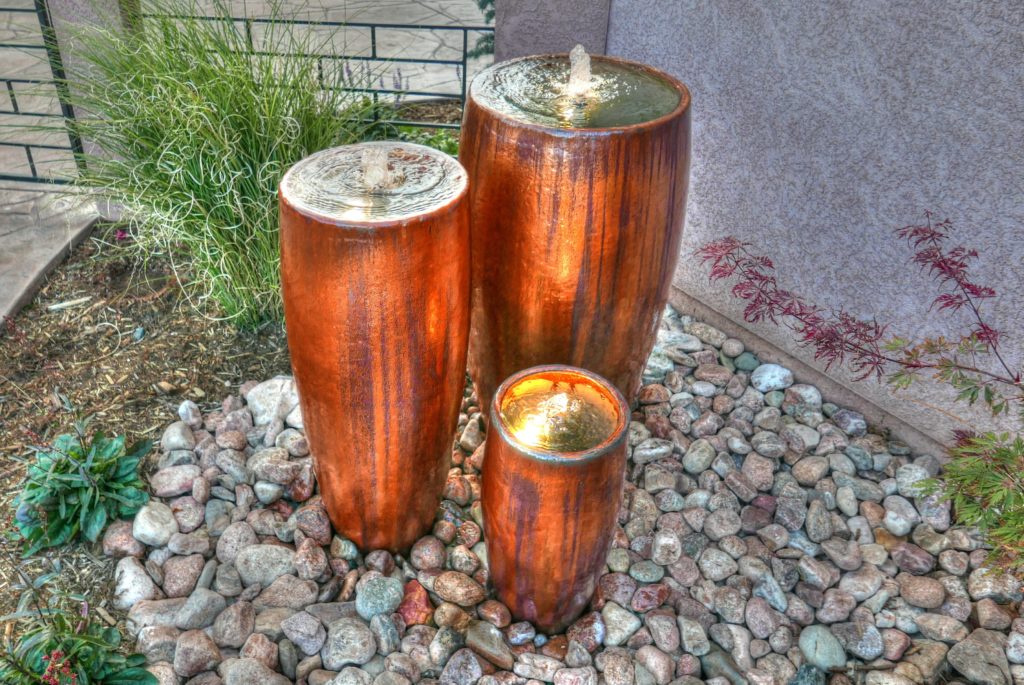The Benefits of a Fountain Landscape
The Benefits of a Fountain Landscape
Water throughout history has had a powerful effect on humans, acting as a healing agent for many. Architects, philosophers, religious healers, and physicians have appreciated the benefits of water for hundreds of years. Landscape designers use water features to create visual and sensory experiences that include the element of sound. Our gardens are always stimulating us visually, but adding a water feature such as a fountain can be a wonderful reminder to listen.
Water features can be calming or act as a dramatic statement depending on their placement within the garden. Fountains are often featured as an energizing addition to the landscape, creating sound and artistic movement. In contrast, decorative or still water features can make a tranquil space, often used for healing and relaxation.
There are many benefits of including a water feature in your fountain landscape:
● Create visual interest, enhance themes and add artistic focal points
● Disguise noise pollution and improve air quality
● Foster relaxation and tranquility
● Improve health
● Prompt mental alertness and concentration
A garden fountain landscape can be included in designs to create impressive cascading effects or subtle expressions. Fountain style and size are often determined based on your home's architectural style, the theme of your landscape design, and the area available within your landscape. Imagine the type of atmosphere you would like to create within your landscape. Identifying your theme or style will guide your decision on the kind of fountain you would like to incorporate into your landscape.

Fountain Landscape Options
Free-standing fountains
Free-standing fountains are often constructed with a collection pool surrounding the base or set on a rock bed bordered by plantings. Free-standing fountains without a base are referred to as Disappearing fountains. Disappearing foundations include a below-ground reservoir where water is circulated throughout the system. These types of fountains are often quieter and sometimes referred to as Bubblers. Fountains with pools surrounding the base are usually larger and create more noise.
Wall fountains
Wall fountains are installed both on the interior and exterior of your home. The vertical structure is used because of its simplicity and small water pool at the base. This style of fountain often requires very little space, which can be ideal for small areas. Wall-mounted or free-standing, the structure includes a spout, water basin, internal tubing, and a pump.
Pond fountains
Pound fountains are categorized into two types, decorative fountains and aerating. Decorative fountains range in size and are constructed in proportion to space where installed. Aesthetically pleasing, decorative fountains use movement through nozzles to create different patterns such as starbursts and cascading tiers.
While decorative fountains create stimulating visual effects, aerating fountains provide the best vertical circulation and help sustain ponds and lakes' health.
Bowl or urn fountains
Bowl or Urn Fountains are used as a beautiful addition to the landscape and requires more space when used as a focal point or design accent. Fountains can be customized with lighting and can create visual patterns through the variations and movement of water.

Fountain Landscape Sizes
Fountains Size
When deciding on fountain size, it is essential to pay attention to the proportion of your outdoor space, as well as the scale of your home. A sizable free-standing fountain that complements a home's architecture can be a beautiful addition or focal point in a large yard. If you are looking for a water feature to enhance a sitting area or a secluded garden, your space may require a simple wall fountain.
Fountain Landscape Materials
Garden fountains are made with many different materials. The architecture of your home is a great way to guide your material selections.
The typical fountain landscape is constructed of:
● Cast Stone
● Fiberglass
● Resin
● Concrete
● Other
Maintaining Your Fountain Landscape
Fountains do not require a lot of maintenance. Although, for those who live in a northern region, your fountain may require extra care before the cold winter months. Stone, concrete, and fiberglass fountains have the potential to freeze in cold conditions. It is essential to dry out all piping and water inside the fountain before winter hits.
For homeowners who experience harsh winter conditions, a good alternative would be to install a fiberglass fountain. Fiberglass fountains provide flexibility and can be stored or featured inside during the winter months.
What are the Costs of Fountains?
The cost of fountains varies greatly depending on the size, style, and feature. Small fountains and wall fountains are less labor-intensive to install, but larger fountains and added features can increase the price.
Accent Landscapes installs a wide array of water features. Including a water feature in any design will add to your landscape's overall theme and create a beautiful focal point while entertaining guests or relaxing in the garden. You can view some of our water feature designs on our website or at our Houzz profile.